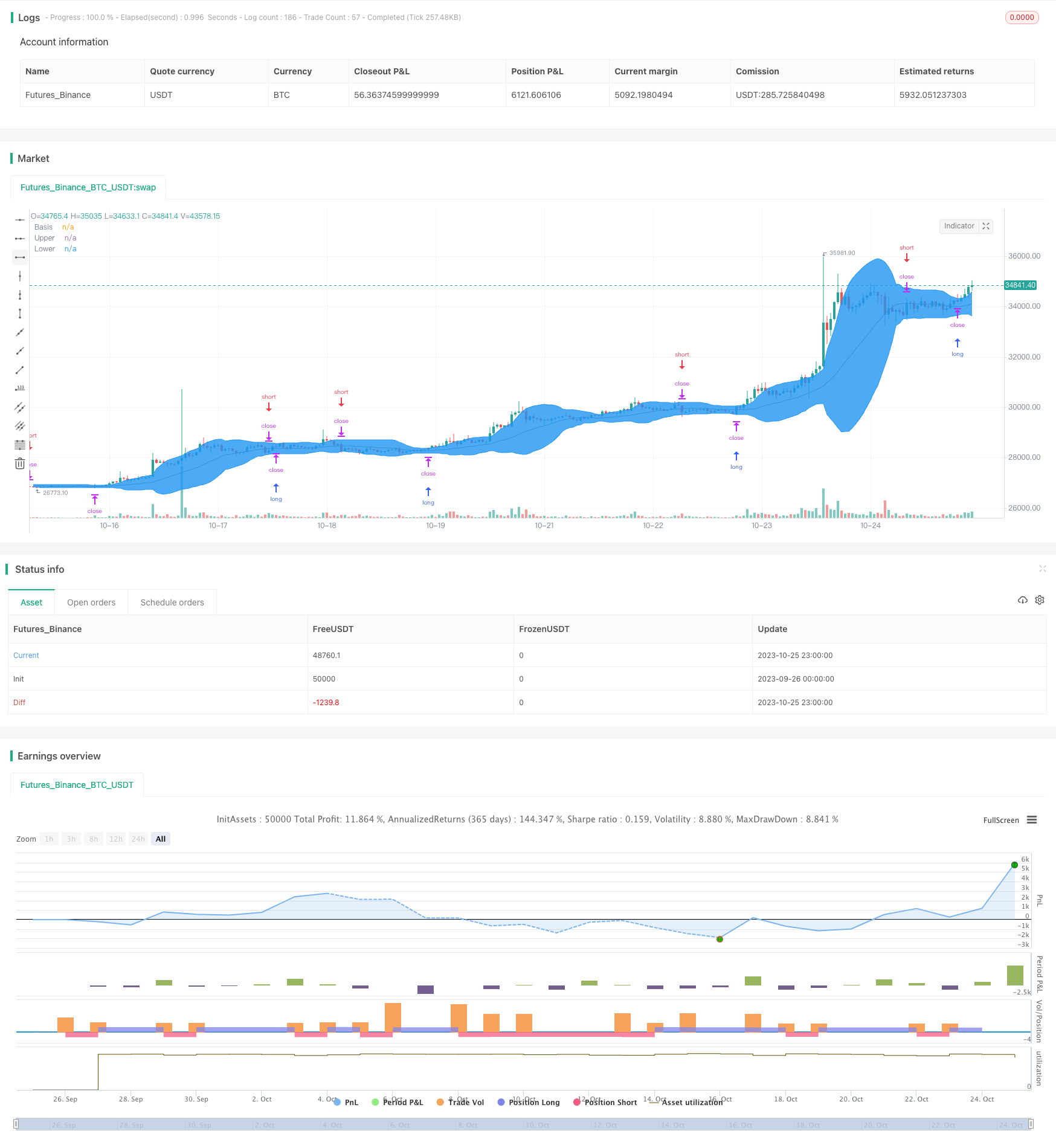
概述
本策略基于布林带指标进行交易信号判断,使用止损止盈方式进行仓位管理。策略会监控布林带上轨和下轨的突破情况,在价格突破布林带上轨时做多,突破下轨时做空,并在反向突破时使用止损单平仓。
策略原理
该策略使用布林带指标中的中轨、上轨和下轨线。中轨线是计算一定周期内的价格中值,上轨线是中轨线加上标准差的两倍,下轨线是中轨线减去标准差的两倍。
代码首先计算布林带的中轨、上轨和下轨。然后,判断价格是否突破上轨或下轨,如果突破上轨则做多,如果突破下轨则做空。同时,如果价格反向突破上轨或下轨,则使用止损单平仓。
具体来说,策略逻辑如下:
- 计算布林带中轨、上轨、下轨
- 如果价格突破上轨,做多开仓
- 如果价格突破下轨,做空开仓
- 如果有做多仓位,价格突破下轨,使用止损单平仓
- 如果有做空仓位,价格突破上轨,使用止损单平仓
通过这种方式,可以在股价产生较大波动时捕捉趋势,同时也可以通过止损来限制亏损。
优势分析
- 使用布林带指标判断入场时机,可以有效捕捉价格突破后的趋势行情
- 做多做空信号明确,操作规则简单清晰
- 使用止损单策略,可以限制单笔交易的最大损失
- ParameterHandler可调整布林带参数,优化策略
风险分析
- 布林带交易容易产生多次小额止损单损失,造成整体盈亏受损
- 布林带参数设置不当可能导致交易频率过高或信号错失
- 仅考虑价格因素,没有结合其他指标来综合判断行情
- 没有考虑突破点附近的止损线调整,可能扩大损失
可以通过Combine指标组合,适当调整止损单位等方式来优化。
优化方向
- 可以考虑结合其他指标,如交易量、移动平均线等来确认突破信号
- 可以根据不同市场调整布林带参数,优化参数组合
- 可以根据突破点调整靠近的止损距离,避免过于敏感
- 可以考虑结合海龟交易法则,只在趋势形成后进行交易
- 可以结合机器学习算法自动优化布林带参数
总结
本策略基于布林带指标设计了一个较为简单的趋势跟踪策略。它可以在价格产生突破时快速形成仓位,同时利用止损来控制风险。但仅考虑价格因素可能导致误判,而过于灵敏的止损又可能增加交易频率。我们可以通过参数优化、指标组合、止损调整等方式进一步完善该策略。总体来说,本策略为我们提供了一个相对简单可靠的量化交易思路。
策略源码
/*backtest
start: 2023-09-26 00:00:00
end: 2023-10-26 00:00:00
period: 1h
basePeriod: 15m
exchanges: [{"eid":"Futures_Binance","currency":"BTC_USDT"}]
*/
// This source code is subject to the terms of the Mozilla Public License 2.0 at https://mozilla.org/MPL/2.0/
// © ROBO_Trading
//@version=5
strategy(title = "Bollinger Stop Strategy", shorttitle = "BBStop", overlay = true, default_qty_type = strategy.percent_of_equity, initial_capital = 10000, default_qty_value = 100, commission_value = 0.1)
//Settings
long = input(true)
short = input(true)
length = input.int(20, minval=1)
mult = input.float(2.0, minval=0.001, maxval=50)
source = input(close)
showbb = input(true, title = "Show Bollinger Bands")
showof = input(true, title = "Show Offset")
startTime = input(defval = timestamp("01 Jan 2000 00:00 +0000"), title = "Start Time", inline = "time1")
finalTime = input(defval = timestamp("31 Dec 2099 23:59 +0000"), title = "Final Time", inline = "time1")
//Bollinger Bands
basis = ta.sma(source, length)
dev = mult * ta.stdev(source, length)
upper = basis + dev
lower = basis - dev
//Show indicator
offset = showof ? 1 : 0
colorBasis = showbb ? color.gray : na
colorUpper = showbb ? color.blue : na
colorLower = showbb ? color.blue : na
colorBands = showbb ? color.blue : na
p0 = plot(basis, "Basis", color = colorBasis, offset = offset)
p1 = plot(upper, "Upper", color = colorUpper, offset = offset)
p2 = plot(lower, "Lower", color = colorLower, offset = offset)
fill(p1, p2, title = "Background", color = colorBands, transp = 90)
//Trading
truetime = true
if basis > 0 and truetime
if long
strategy.entry("Long", strategy.long, stop = upper, when = truetime)
if short
strategy.entry("Short", strategy.short, stop = lower, when = truetime)
if long == false
strategy.exit("Exit", "Short", stop = upper)
if short == false
strategy.exit("Exit", "Long", stop = lower)
if time > finalTime
strategy.close_all()